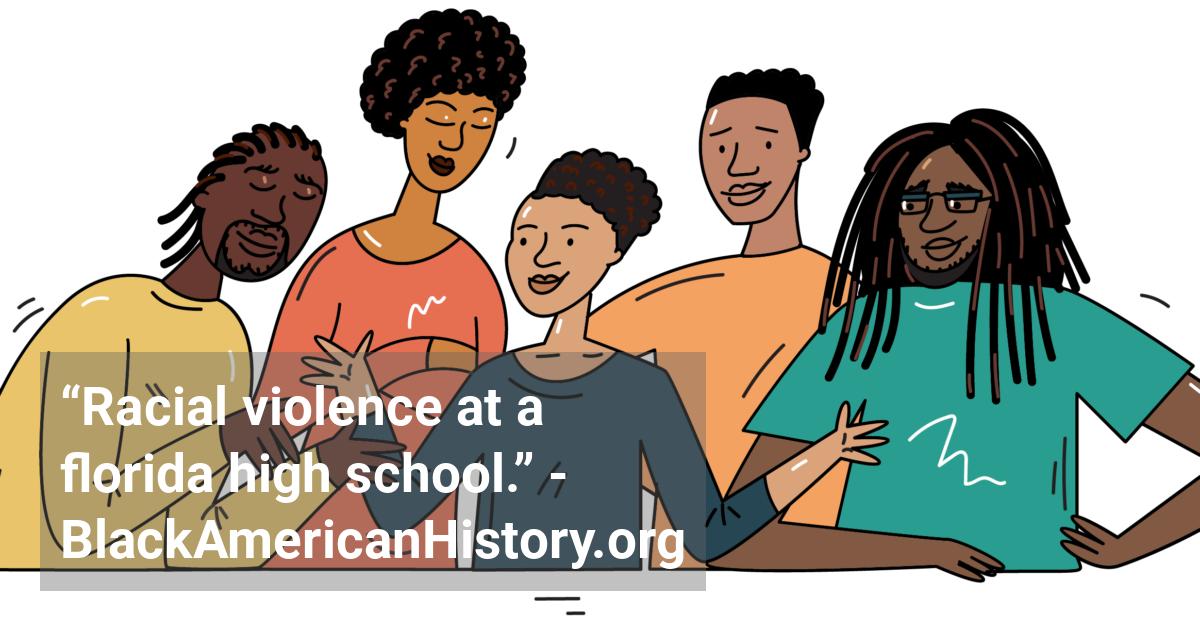Home / Full timeline / Racial violence erupts in Pensacola, Florida, over the issue of whether athletic teams at a local high school would be called “Rebels” or “Raiders.”
 Racial violence erupts in Pensacola, Florida, over the issue of whether athletic teams at a local high school would be called “Rebels” or “Raiders.”
Racial violence erupts in Pensacola, Florida, over the issue of whether athletic teams at a local high school would be called “Rebels” or “Raiders.”
1976 (Feb 5 - 26)
Racial violence erupted in Pensacola, Florida, over the issue of whether athletic teams at a local high school would be called "Rebels" or "Raiders." On February 5, fifteen hundred people rioted at the Escambia High School. Four white students were wounded by gunfire, six others were also injured, and at least nine people were arrested. One of these was a twenty-three-year-old Black man who was suspected in the shootings. Subsequently, crosses were burned on the lawns of school board members, a bullet was fired through a window of a home owned by a Black school board member, and the homes of a human relations council member and a state legislator were burned by arsonists. Blacks began a boycott of the school. On February 9, one hundred of the six hundred Blacks enrolled in Escambia High School attended classes, but they were met with taunts from whites. Nearly one thousand white students also remained out of class “apparently in anticipation of violence.” The school had a total enrollment of 2,523 students. The only incident of the day, however, was the arrest of a fifteen-year-old white youth who was brandishing a foot-long chain "equipped with a bolt-type grip." On February 21, the home of Teresa Hunt, a member of the Pensacola-Escambia Human Relations Commission and the county school board Citizens Advisory Committee, was set afire with diesel fuel. Four nights later, the home of State Representative R. W. Peaden, a block away from Hunt's residence, was destroyed when a flammable liquid was poured on its floors and ignited. Both Hunt and Peaden had been involved in the controversy over the school name. The Escambia Chapter of the Southern Christian Leadership Conference (SCLC) continued to urge Black parents to keep their children away from the school, warning that they would be unsafe there. The chapter's president, F.L. Henderson, remarked, "We'd rather see a child held back in school than see them in the morgue." He asked Florida Governor Reuben Askew to provide "as much protection as within his power" for Black students. The controversy over the school's nickname first arose in 1973 when Black students, who had been attending the school since 1969, protested both the name and the flying of the Confederate flag at athletic events and other functions. They said both symbols were a direct insult to them. After several protests, some of which were accompanied by violence, a U.S. District Court, on July 24, 1973, permanently enjoined the use of the rebel name, the flag, "and related symbols on the grounds that they were 'racially irritating.'"Students then chose the name “Raiders” to represent the school. But after an appeal by a group of white students and school board members, a U.S. Court of Appeals overturned the injunction and returned the matter to the school board to make its own decision on the name." On February 4, 1976, an election was scheduled at Escambia High to allow students to choose between “Raiders" and "Rebels." The riot erupted the next day.
References:
- • Hornsby, Alton. Chronology of African-American History: Significant Events and People from 1619 to the Present. Detroit: Gale Research, 1995.
